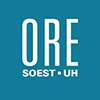To subscribe to the ORE seminar mailing list, click here.
For a (working draft) list of upcoming seminars, click here.
If you are interested in giving an ORE seminar, please contact us at nosal [at] hawaii [dot] edu.
fluid-structure interaction
Latest Past Events
MS Plan A Defense: Fluid-Structure Interaction Analysis of an Oscillating Wave Surge Energy Converter using LS-Dyna
POST 723 1680 East-West Road, HonoluluKyle Pappas Master’s Student Department of Ocean and Resources Engineering University of Hawai’i at Mānoa **This defense will be held both in person (POST 723) and over Zoom** Meeting ID: 936 1681 5822 Passcode: KyleMS https://hawaii.zoom.us/j/93616815822 Three-Dimensional two-way coupled fluid structure interaction (FSI) analysis requires a complex strategy utilizing the finite element method (FEM) for large matrix computations. Two FEM solvers in LS Dyna are utilized to conduct a structural analysis of the Hawai’i Wave Surge Energy Converter (HAWSEC) for a particular wave condition case study that is directly compared with experimental results. The HAWSEC is a hollow, surface piercing,
Seminar: Fundamentals of Collision and Constraint Dynamics: Review and Potential Applications in Ocean Engineering
Zoom Meeting ID______ 935 9608 7383 Passcode: OREseminarAlbert S. Kim Professor and Graduate Chair Department of Civil and Environmental Engineering University of Hawai'i at Mānoa Hydrodynamic impacts and interactions between fluid flow and solid objects--both moving and stationary--are of great importance in various engineering disciplines from nano- to ocean-scale phenomena. These processes include aggregate/aggregation dynamics of sub-micron particles (as point masses), granular dynamics (as inelastic bodies of finite volumes) for pharmaceutical manufacturing processes and sediment transport in ocean engineering, and classical dynamics of rigid bodies as big as vehicles and shipping containers. Although the collision and constraint dynamics applications have vast length-scale ranges, the principles and
Seminar: Understanding the Fundamentals of Vortex-induced Vibrations: Research Past, Present and Future
Deniz Gedikli, PhD Assistant Professor Ocean and Resources Engineering Department, University of Hawaii at Manoa Figure 1: Example offshore platforms that undergo VIV The canonical problem of fluid flow across an elastically mounted circular cylinder has been a widely studied problem in fluid mechanics due to the ubiquitous nature of the simple geometry in engineering applications and the resulting complexity of the fluid-structure interaction. In many engineering design and operation applications, it is advantageous to be able to predict fluid-structure interactions such as self-limiting vortex-induced vibrations, since these vibrations can strongly affect fatigue life or operational downtime in a variety
